Where is Nitric Oxide Nasal Spray Available?
Nitric Oxide Nasal Spray (NONS) is currently sold as a medical device in Thailand, Hong Kong, Singapore, Indonesia, Israel, and Bahrain. Nitric Oxide Spray is available on eBay, or at the enovid online store.
In India, NONS has emergency use approval for treatment of high risk adult patients with COVID-19. It is registered as a Class I medical device in the European Union.

Nitric oxide has been used medically for years and is known to be safe, but this new use has had some challenges in getting regulatory approval. This is because Nitric Oxide Nasal Spray is a gas within a liquid, which is completely different from any other type of medication.
Clinical Trials are underway in the UK, Canada, and SaNOtize is working towards regulatory approval in Canada and the USA.
Who Developed Nitric Oxide Nasal Spray?
Dr. Gilly Regev and Dr. Chris Miller are co-founders of SaNOtize, a a pharmaceutical company based in Vancouver, Canada. SaNOtize was founded in 2017 to create treatments based on the antimicrobial properties of nitric oxide (NO), a naturally occurring molecule known to have antibacterial, antifungal, and antiviral properties.

Dr. Regev has PhD in Biochemistry, 30 years of research experience, with 12 years in the field of nitric oxide research.
Dr. Miller has a PhD in Experimental Medicine and is a Retired Assistant Professor in the Faculty of Medicine at the University of British Columbia in Canada.
Early on in his career Dr. Miller worked as a respiratory therapist on a neonatal unit where nitric oxide is often used to treat blue babies. He then became fascinated by with the antimicrobial activity of NO and since 1997 has been researching and developing the use nitric oxide to help people with infectious diseases.

How Does This Anti COVID Nasal Spray Work?
Dr. Regev says using Nitric Oxide Nasal Spray (NONS) in the nose is like using hand sanitizer on the hands.
Nitric oxide has a proven virucidal action against the SARS-CoV-2 and other respiratory pathogens.
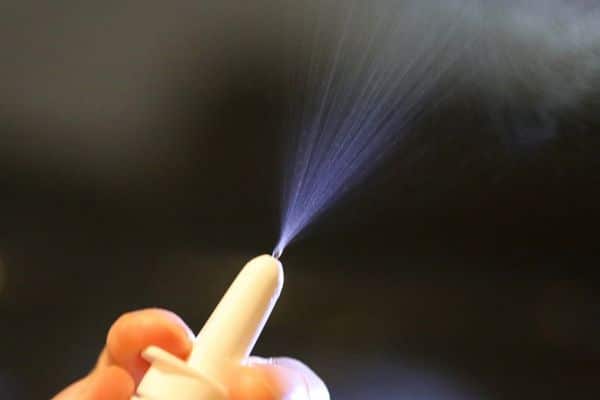
Nitric oxide works two ways: it stops the virus from entering cells and it stops it from replicating.
It breaks down the viral proteins that the virus needs to enter the cells through through angiotensin converting enzyme 2 (ACE-2), and it also interferes with proteins the virus needs to replicate.
So you use it in your nose like you use hand sanitizer on your hands, to kill COVID and other viruses.
How Do You Use Nitric Oxide Nasal Spray?
Nitric Oxide Nasal Spray (NONS) kills viruses on contact so it makes sense to use it after a possible exposure to kill any virus that you breathed in to your nose. This can stop the virus from entering the body through the nose and replicating.
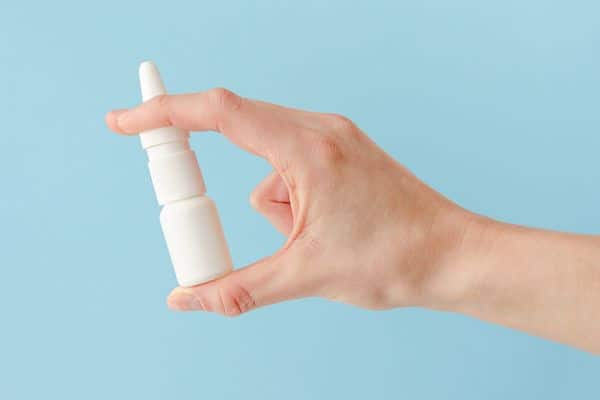
You pump the spray into both nostrils and the goal is to saturate the surface inside the nose.
The enovid instructions say to first gently blow your nose.
Then you insert the bottle into one nostril, press your finger against your other nostril to close it off and pump one spray into your nose.
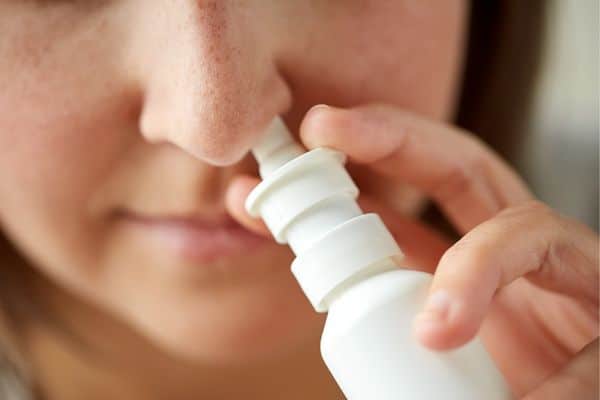
You use the spray bottle vertically as in this photo, not horizontally. The idea is to keep most of the spray in the front part of your nasal passages
They recommend 2 sprays into each nostril. You can do this 2-3 times a day, or up to 6 times per day following suspected exposure to viruses.
The spray is designed so that the droplet size is bigger than the size that you would inhale. The idea is to keep the spray in the nose and upper airway where they are targeting the viruses rather than have it go into the lungs.
Breathing nitric oxide is safe, it is actually used medically to treat lung infections. But the NONS spray is designed specifically to work in the nose and the upper airway.
What are the Ingredients in NONS?
Here is the cool thing about the NONS spray bottle: It has two chambers and two ingredients (sodium nitrite and citric acid) of the spray mix together when it is administered to form nitric oxide.
So the nitric oxide is made just as you are using the spray, which is required because of the nature of nitric oxide. Pretty cool right?
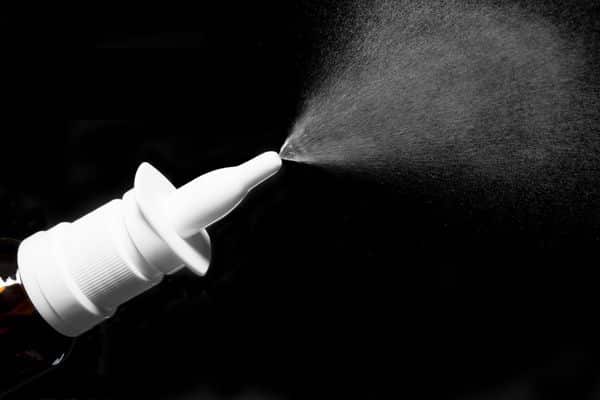
The enovid spray has these ingredients:
- Sodium Choride
- salt solution
- Citric Acid
- acid to make the nitric oxide
- Hydroxypropyl Methylcellulose
- a commonly used thickening agent in eye drops and lubricants
- also used in allergy sprays to create a protective coating in the nasal passages
- Sodium Nitrate
- component needed to make the nitric oxide
- Benzalkonium Chloride
- preservative used in eye drops
- also has antimicrobial activity
Is Nitric Oxide Safe?
Yes, nitric oxide (NO) is safe. Inhaled nitric oxide has been given as a treatment for premature babies. NO has also been used to treat viral lung infections in people with cystic fibrosis.

NO is naturally produced in our bodies as part of our immune response. In addition to its antiviral effects, NO is critical in maintaining the lining of our blood vessels, regulating the immune response, and has protective properties in the lungs.
NONS Reduces Infection Rate After Exposure to COVID?
A Study in February 2022 during an Omicron outbreak involved students who had been exposed to a roommate with confirmed COVID. This was a known exposure without a mask for at least five minutes.
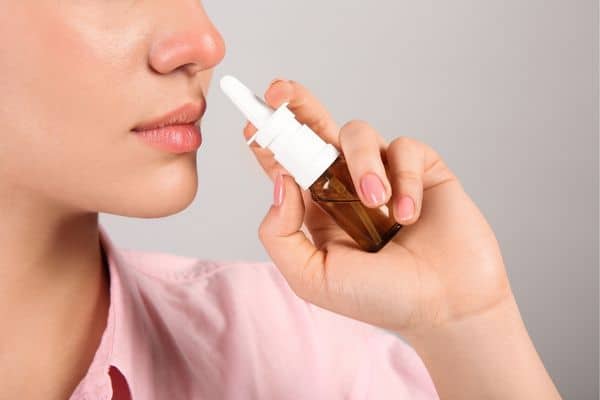
There were about 600 people in the study, 203 participants who used NONS and 422 in the control group. The students that used Nitric Oxide Nasal Spray had a lower rate of infection with COVID, only 6% tested positive for COVID, compared to 26% in the control group.
Nitric Oxide Nasal Spray Can Shorten Time to A Negative COVID Test?
In another study they showed that if you are COVID positive, using NONS reduces the viral load in the nose rapidly and effectively. Using Nitric Oxide Nasal Spray shortens the time to a negative negative PCR.
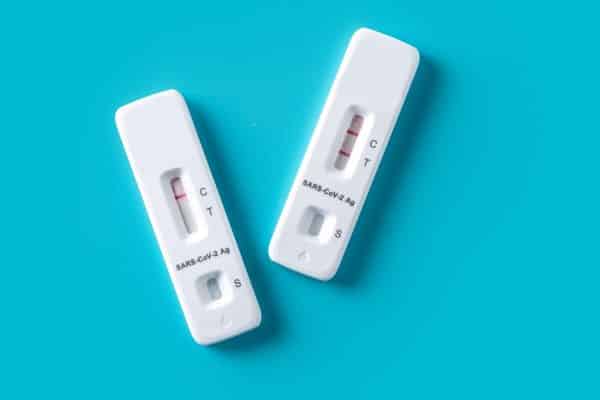
It took three days from starting the treatment to go from COVID positive to COVID negative versus seven days without treatment.
That’s cool, but to be honest I’d really like to also see some evidence that there is a systemic lowering of the virus, like less virus in the blood. That would be very exciting.
Nitric Oxide Nasal Spray Could Reduce COVID Spread?
Because using NONS when you have COVID reduces the time it takes to become COVID negative by rapid test, it should reduce how infectious you are.
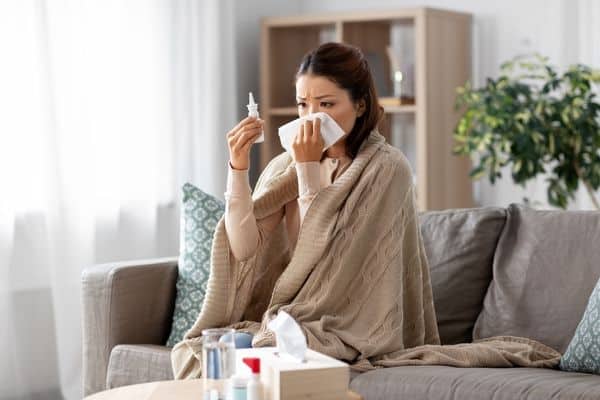
This is a difficult thing to prove scientifically, as it requires a huge amount of people to be studied.
One study seemed to show reduced COVID spread to close contacts but the numbers were very small, so not conclusive.
Nitric Oxide Nasal Spray Shortens the Time With COVID Symptoms?
The were also able to show that it shortens the clinical progression, and the time a person has COVID Symptoms.

People with COVID infections using the spray also were more likely to have no symptoms at the end of the 16 days study.
The results on COVID symptoms are not super impressive to be honest.
At day 8, 78% of people using NONS had improvement in symptoms compared to 62% of people using the placebo nasal spray. So a 14% reduction in symptoms at day 8.
At day 16, 94% of people using NONS had improvement in symptoms compared to 81% of people using the placebo nasal spray. A 13% reduction in symptoms at day 16. It is scientifically significant, but is it significant in real life?
It is actually impressive that they used a placebo nasal spray, that is good science.
The placebo nasal spray was normal saline and benzalkonium chloride which has virucidal activity. So just using a nasal spray with these ingredients might be helpful to reduce symptoms if you have COVID.
Nitric Oxide Nasal Spray Works with Different COVID Variants
The study with the students who were exposed to a roommate with COVID occurred just as the Omicron wave was starting.
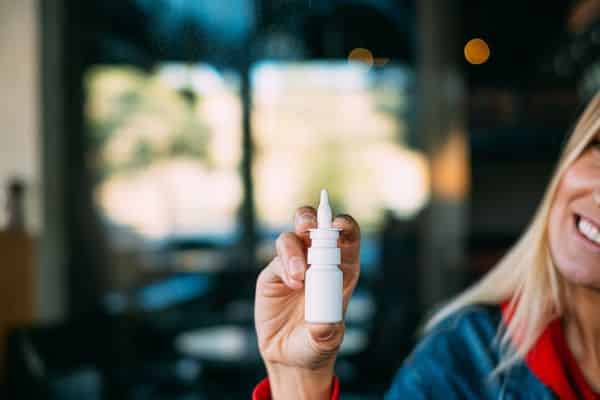
The infected roommates had Delta and Omicron variants in almost a 50/50 split and there was no difference seen based on which variant it was. So this indicates that NONS works across different COVID variants.
Side effect of Nitric Oxide Spray
So, this is all very interesting. But are there side effects to using Nitric Oxide Nasal Spray (NONS)? Not really.

Even when nitric oxide nasal spray was used six times per day for seven days there were no serious side effects.
Only a few of people in a study (6.5%) reported any side effects, and they were all mild. Some people find that there is a bit of a burning sensation in the nose.
Personal Experience with Nitric Oxide Nasal Spray
I ordered Sanotize Nasal Spray from the online enovid store, you can also get it on eBay. I thought it would be nice to have it available if I needed it.
Unfortunately just after I ordered it my husband felt unwell and tested positive for COVID. Let me tell you, I really wished I had it.
I was on my third day of being positive for COVID by the time it arrived (4 days after my husband tested positive), but I used it a few times a day for the next 5 days.
Did it help? I’m not sure to be honest. But it was pretty easy to use.
The instructions say to use 2 sprays per nostril, but I just used 1 spray. Based on listening to the podcast interview with the scientists it seems the 2 spray dose is so that the spray covers the nostril of any person. I’m a small woman so I just went with 1 spray.
It was easy to use, I felt a tiny bit of burning but it was fine. I also sometimes sniffed after the spray which i think pulled it into my sinuses.
I was very stuffed up with my infection and I did find that the NONS spray helped with this, so I appreciated that.
I do not know if it shortened the time I was positive, which was about the same as my husband. Again, I really wish I could have started it as soon as we knew he was positive, not 3 days in.
Best Use of Nitric Oxide Nasal Spray
The best way to use Nitric oxide nasal spray seems to be as a preventative. Use it if you are going to have a risky exposure. Like a meal at a busy restaurant, or a plane trip.
When used as a preventative the nitric oxide nasal spray should be used along with other prevention methods like masks and improving ventilation.

Another reason to use it is if you realize you just had an exposure, like a friend you just spent time with tells you they tested positive.
The thing is that NONS basically sanitizes your nasal passage, killing any bacteria or virus in your nose. It might seem like a good idea to kill any bacteria in your nose, but we not all bacteria are bad. We all have a microbiome in our nasal passage, when we are healthy we have a good balance of healthy bacteria.
This is a good thing, so you don’t want to mess with your microbiome unless you need to.
But when we are exposed to something as harmful as COVID, we want to destroy it before it can infect us. So it is probably worth killing our nasal microbiome if it means we stop COVID from infecting us or we can reduce the infection.
One of the scientists who developed the spray suggests using it daily. Personally, I wouldn’t use it daily, I think we underestimate the importance of our symbiotic relationships with our microbiomes. I’d rather wear a mask to reduce risk to COVID generally.
But I would absolutely use it after a close COVID contact or a risky exposure. Both of which have happened recently.
You can also use it when you start to get symptoms but the studies were not super impressive in NONS reducing COVID symptoms. (And this correlates with my experience.)
However, it may be that using NONS if you have COVID will reduce your chance of spreading COVID. The studies on this are not conclusive, but NONS might be useful to use when you are trying to reduce COVID spread to close contacts you live with.
Again, using masks, isolating and improving ventilation should also be used to reduce the spread.
References
- Dual effect of nitric oxide on SARS-CoV replication: Viral RNA production and palmitoylation of the S protein are affected
- Clinical efficacy of nitric oxide nasal spray (NONS) for the treatment of mild COVID-19 infection
- SARS-CoV-2 accelerated clearance using a novel nitric oxide nasal spray (NONS) treatment: A randomized trial
- Out of the Doldrums – Nasal Nitric Oxide Spray Update – an Interview with SaNOtize
- Hydroxypropyl Methylcellulose-Based Nasal Sprays Effectively Inhibit In Vitro SARS-CoV-2 Infection and Spread
- A nitric oxide-releasing solution as a potential treatment for fungi associated with tinea pedis